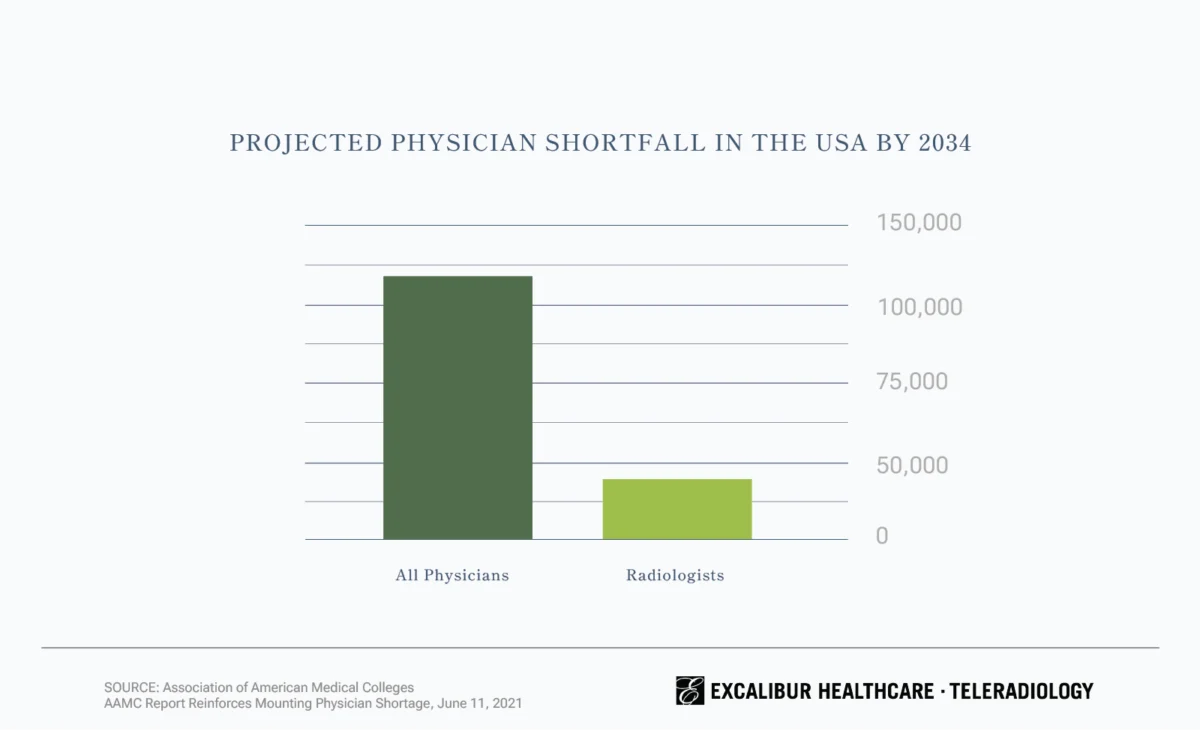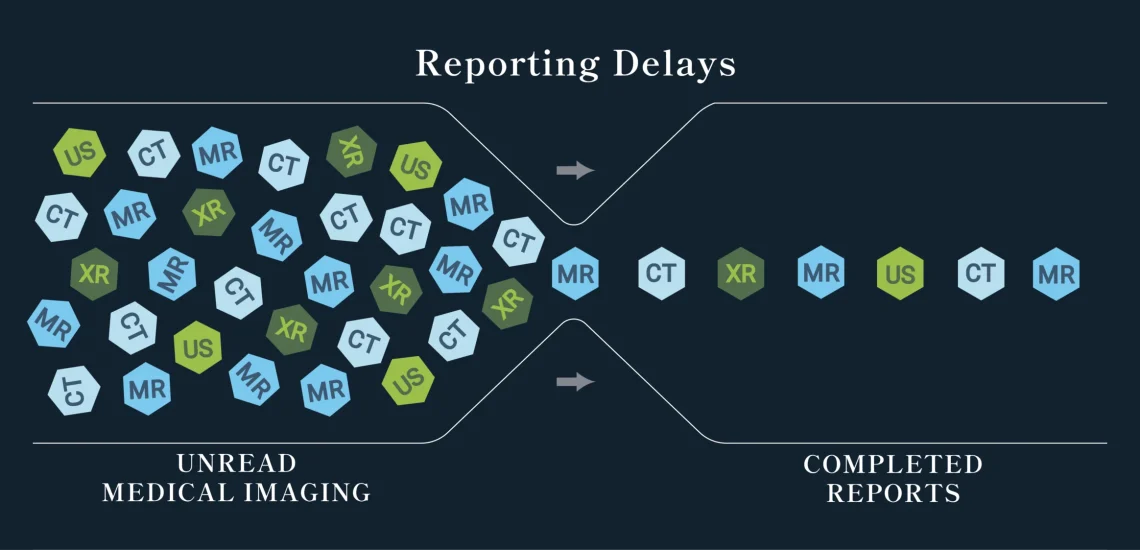Delayed reports. Imaging Backlog. Bottlenecks. Overflow.
However you describe it, reporting delays in medical imaging are a pressing issue that not only affects patient care, but also your radiologists’ wellbeing. Facilities are struggling to keep up with volumes of exams, such as X-rays, Ultrasounds, CTs and MRIs. The job isn’t finished until the worklist is complete, and the worklist isn’t getting completed. How did we get here? How can we alleviate reporting delays in medical imaging when there is a shortage of radiologists in the workforce? What other factors contribute to this backlog problem?
What is reporting backlog?
Medical reporting delays occur when a health system, hospital or medical imaging provider’s volume of imaging (such as X-rays, CT scans, and MRIs) exceeds the capacity of radiologists available to read them in a timely manner. Reports pile up unread while more imaging requests continue to accumulate. It is not unlike a traffic jam, but instead of cars on a highway, it’s images waiting for review by a specialist.

Why are reporting delays increasing?
There are multiple factors as to why reporting delays in medical imaging have become prevalent lately.
Michael Bruno, MD, vice chair for quality and patient safety at Penn State Milton S. Hershey Medical Center spoke on the topic at the RSNA23 sessions. He said, “We have a great mismatch right now between the great resignation, the loss of manpower and the exploding increase in demand. We are seeing a huge rising volume, and a lot of this is for low-value, unnecessary care.”
We agree with his comment here at Excalibur. Our staff observes these reasons taking a toll on the radiology landscape. We interact with others who share anecdotes of radiologist burnout in their practices. Some express wishes, if not plans, of an earlier retirement. We also witness a growing role of NPPs (non-physician practitioners) in the ordering of medical imaging.
Radiologist Shortage
The shortage of qualified radiologists is already a problem. On the American College of Radiology‘s job board there are currently more than 1,850 open radiologist roles. According to data published in the Association of American Medical Colleges, by 2034 there will be a shortage of upwards of 124,000 physicians, 10,300-35,600 of them being radiologist alone.

Scope of Practice Expansion a contributor
There has been an uptick in scope of practice legislation which allows clinicians the ability to practice physician level tasks such as ordering imaging. Proponents of the legislation argue it improves access to healthcare, especially in areas lacking enough physicians. However, The American Medical Association and others express concerns about resulting patient safety issues and costliness.
How does scope creep play into today’s reporting delays? “A study in the Journal of the American College of Radiology which analyzed skeletal x-ray utilization for Medicare beneficiaries from 2003 to 2015 found ordering increased substantially—more than 400% by nonphysicians.” Dr. James L. Madara, MD, AMA CEO wrote in a letter to the Governor of Georgia, highlighting a possible NPP’s tendency to overorder imaging, adding to the increase in imaging delays.
Delays in reporting affect quality of care
The largest concern with reporting delays in medical imaging should be a patient’s quality of care. If patients are facing imaging delays of upwards of 2 weeks, they simply are not receiving the quality of care they need and deserve.1 These delays in interpretation lead to patients not receiving timely diagnoses and necessary treatment. Not only does it create frustration and anxiety due to extended wait times, it can pose a serious health risk if medical conditions that are present worsen due to delayed intervention.
“Although many patients do not have a face-to-face encounter with their radiologist, radiologists care for more Medicare beneficiaries per year than any other physician, which indicates radiology’s prominent role in patient care. As a result, the demand for imaging services continues to rise and the supply of radiologists is increasingly unable to meet that demand.”2
What does the future hold?
Congress is being urged to take immediate action to increase the supply of radiologists in the US. Proposals for retaining international medical graduates, utilizing unused physician visas, and expanding residency programs are all on the table. However, navigating the legislative process can be slow, leaving the supply and demand gap unaddressed in the short term.
Is your facility struggling with overflow?
The ideal solution would be to simply hire more radiologists for your team. However, the nationwide shortage makes employment increasingly expensive and difficult, especially for smaller facilities and in rural areas. As volume surges and the unfinished worklists demand attention, perhaps it is time to consider another solution.
Teleradiology Can Help
Teleradiology services can be leveraged as a viable solution to alleviate the nationwide problem of delayed reports. Here at Excalibur, we are familiar with this situation. Currently, we have radiologists who are dedicated to overflow, blended seamlessly into our client’s in-house staff. They help read the imaging backlog of our client’s facilities. Our USA-based radiologists work remotely to provide high-quality, final reads to reduce worklist overflow.
“We already have a partnering radiology practice.”
Are you a facility under contract, but facing reporting delays with a partnering radiology practice? If reporting delays are affecting your business relationship, let your current provider know about Excalibur Healthcare teleradiology. We could be able to help them reinforce the support you are already getting.
“We are a radiology practice.”
How deep is your imaging backlog? Radiology practices, call us to discuss how to add more radiologist power to your team by working with ours. Together, we can help you fulfill your service agreements. If you are behind on your reports and need an ally to support your in-house team, Excalibur can help.
Let’s work together to ensure patients receive the quality, timely care they deserve.
Excalibur’s teleradiology services can be customized to coordinate seamlessly with YOUR facility and YOUR workflow. Let’s have a discussion about how we can work together. Please give us a call or contact us to get the conversation started.

Sources
- https://radiologybusiness.com/topics/healthcare-management/healthcare-staffing/radiologist-shortage-leaves-patients-facing-imaging-delays-upward-2-weeks-1-state?utm_source=dlvr.it&utm_medium=twitter ↩︎
- https://radiologybusiness.com/topics/healthcare-management/healthcare-policy/acr-urges-swift-congressional-action-increase-supply-radiologists?utm_source=newsletter&utm_medium=rb_weekly ↩︎
Latest Posts from the Excalibur Blog
- USA-Based Teleradiology: Location Still Matters in 2024
- Scope Creep in Radiology: 6 Important Articles We’re Reading in 2024
- Brianne Boyd of Rural Imaging Services, Sonographer and Rural Healthcare Entrepreneur
- Teleradiology staffing solution: Excalibur can help remedy your radiologist staffing gaps and overflow, with 6 benefits
- More Radiology Bankruptcy in 2024? What We’re Reading


